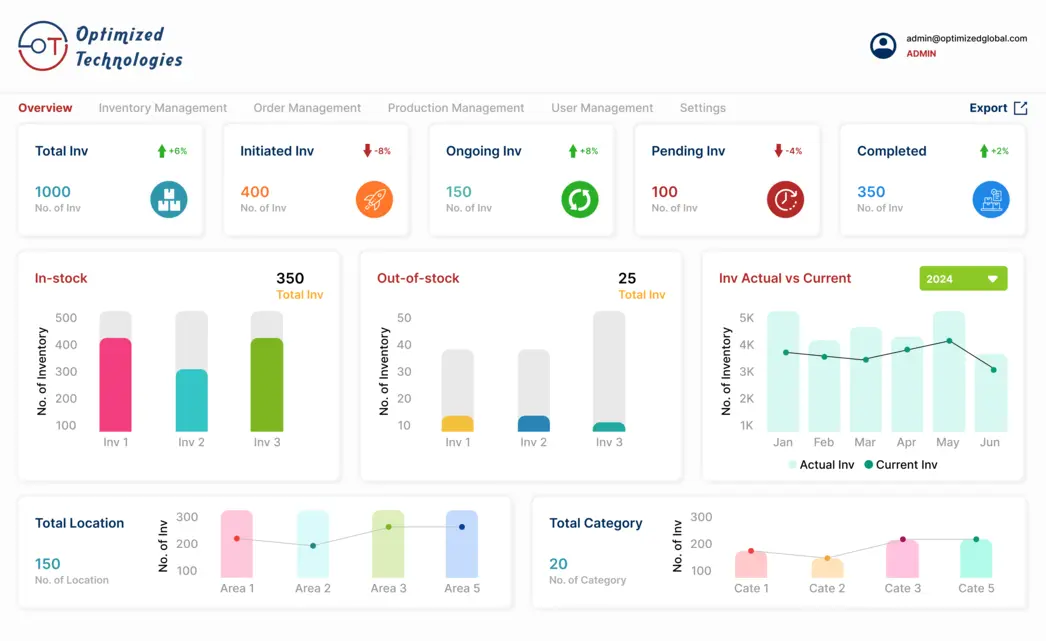



















OTI IoT

OTI-IoT Modules and Features
Real Time Monitoring
IoT real-time monitoring management is crucial for maintaining the health and efficiency of interconnected devices. By continuously collecting and analyzing data, it enables prompt issue detection, proactive troubleshooting, and effective decision-making to ensure optimal performance and user experience.

Rule Management
Rule management in an IoT solution entails creating protocols that automate actions based on real-time device data, streamlining operations and reducing manual intervention. This enables organizations to optimize efficiency and responsiveness while maintaining a proactive approach to device management.

Company Management
The comprehensive company management system empowers the admin to effortlessly add, edit, or delete companies, while easily monitoring their active/inactive status and payment-related information. This streamlined approach enhances administrative efficiency, ensuring seamless control.

User Management
IoT user management plays a pivotal role in granting secure and controlled access to the interconnected system. It involves authentication, authorization, and access control mechanisms, ensuring that authorized users can interact with the devices while safeguarding against unauthorized access and data breaches.

Log Management
IoT log management is essential for tracking and recording device activities and events within a connected system. By analyzing logs, identifying anomalies, and detecting patterns, it enables efficient troubleshooting, performance optimization, and security enhancement in the IoT ecosystem.

IoT Consulting
Let us create an IoT strategy, implementation and evolve your IoT solution.
IoT Solutions and Services
Smart Energy

KPI's
Energy consumption efficiency
ECE helps assess how efficiently energy is being utilized, indicating the system's ability to optimize energy consumption.
Real-time data accuracy
RDA ensures the reliability of the data used for decision-making, allowing for accurate insights into energy usage.
Peak load management
PLM is crucial for avoiding energy grid strain and reducing the overall energy costs during peak demand periods.
Energy cost savings
ECS directly measures the financial impact of the IoT-based smart energy monitoring system, showcasing its economic benefits.
Carbon emission reduction
CER highlights the environmental impact of the smart energy monitoring system, promoting sustainability and eco-friendly practices.
Device uptime and reliability
DUR reflects the reliability of the IoT infrastructure and ensures continuous monitoring and data collection.
Preventive maintenance

KPI's
Equipment uptime
Ensures high operational time, measured as (Total operational time / Total available time) * 100.
Mean Time Between Failures (MTBF)
Measures average time between failures, calculated as (Total operational time / Number of failures).
Mean Time to Repair (MTTR)
Lower MTTR indicates quicker recovery from failures, enhancing overall system availability.
Cost of maintenance
Monitoring costs helps ensure that maintenance practices are cost-effective.
Failure prediction accuracy
A higher accuracy rate indicates a more reliable predictive maintenance system.
Safety performance
Effective preventive maintenance should contribute to a safer working environment.
Smart asset

KPI's
Real-time tracking
Monitor asset locations instantly, ensuring swift response and efficient management.
Predictive asset health
Predict potential issues for proactive maintenance, minimizing downtime and optimizing asset health.
Efficient utilization
Optimize asset usage, reducing idle time and enhancing overall productivity.
Maximized availability
Ensure constant asset availability, minimizing downtime and maximizing system reliability.
Unified asset management
Centralize monitoring for diverse assets on a single platform, streamlining operations.
Geo-fencing efficiency
Implement geo-fencing for precise control, triggering actions based on asset location for enhanced efficiency.
Smart agriculture

KPI's
Precision farming ROI
Evaluates the economic benefits of adopting IoT in agriculture.
Crop health monitoring
Early detection of issues for timely intervention and improved yield.
Efficient utilization
Optimize asset usage, reducing idle time and enhancing overall productivity.
Water usage efficiency
Highlights the sustainability of water resources in agriculture.
Moisture monitoring
Ensure ideal plant growth by monitoring soil moisture, preventing water stress, and maximizing water efficiency in agriculture.
Humidity monitoring
Monitor humidity for timely adjustments, mitigating risks like fungal diseases and ensuring optimal environmental conditions for crop health.
Smart inventory

KPI's
Scan/Generate QR
Generating and scanning QR on the basis of In/Out.
Slot management
Showcasing the occupied and vaccant slot
Order management
Placing order on the basis of available inventory and showing real time updates
Production management
Showing all the inventory based on the category
Notification and alerts
Showing real time updates in software as well as via email
Report generation
Download your data in the form of CSV, PDF, PNG, JPG,etc.
Smart factory

KPI's
OEE
Reflects the overall effectiveness of equipment in the production process.
Cycle time
Indicates production speed and efficiency.
Energy consumption
Measures energy efficiency in the manufacturing process.
Machine monitoring
Display inactive and defective machine information using graphical representation
Notification and alerts
Showing real time updates in software as well as via email
Report generation
Download your data in the form of CSV, PDF, PNG, JPG,etc.
OTI-IoT Information Flow
Facilitation of device connectivity via industry standard IoT protocols - MQTT, CoAP, BACnet, WS, AMQP, CAN Bus and HTTPS with deployment supports at cloud, hybrid, and on-premises. On data strategy, OTI-IoT incorporates SFP (Scalability, Fault tolerance, and Performance) at all the three stages of data i.e. Acquisition, Processing, and Visualizing.

IoT Workshop
Unlocking your business potential and accelerating growth with IoT.
Industries We Cover
Automotive
Automotive advances automotive industry accelerates with electric vehicles, autonomous tech. Connectivity transforms driving experience. Sustainable practices rise, redefining mobility through innovation, safety.
Engineering
Engineering sector innovates cutting-edge designs, sustainable solutions. From infrastructure to tech, engineers drive progress, shaping a smarter, greener, and interconnected world.
Retail
Ever-evolving retail landscape embraces e-commerce, personalization. Brick-and-mortar stores adapt with experiential offerings. Technology drives seamless shopping, reshaping customer engagement.
Manufacturing
Industry evolving automation, IoT, and AI optimize production. 3D printing and sustainability trends reshape manufacturing for efficiency, customization, and eco-friendly practices.
Consumer electronics
Consumer tech flourishes dynamic consumer electronics sector thrives on innovation. From cutting-edge smartphones to smart home ecosystems, AI-driven devices enhance convenience
Agriculture
IoT helps agriculture industry optimize farming resources, monitoring livestock health, automating irrigation, and enabling predictive analytics for informed decision-making.